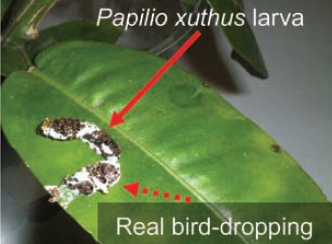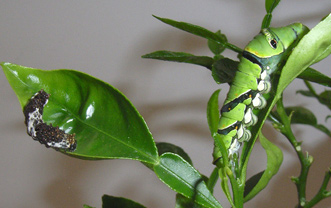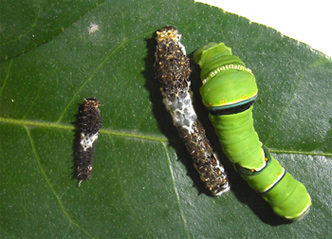Photos: Caterpillar transforms from mimicking bird droppings to a leaf
mongabay.com
February 21, 2008

A larva of swallowtail butterfly Papilio xuthus in its “bird dropping” form (top). A larva of swallowtail butterfly Papilio xuthus changes its body pattern at the 4th molt. The juvenile larva resembles bird droppings (left) in its fourth developmental stage, or “instar,” and its host leaves (right) during its final instar (middle). The 3rd (left), 4th (middle), and 5th (right) instar larvae of swallowtail butterfly Papilio xuthus (bottom). Images courtesy of Ryo Futahashi and Science. |
Scientists have discovered the hormone that enables swallowtail caterpillars to morph from mimicking bird droppings to the bright color form that matches the leaves upon which they feed. The research is published in Science.
University of Tokyo biologists Ryo Futahashi and Haruhiko Fujiwara found that levels of this hormone, called juvenile hormone, decrease at the end of the bird-dropping stage. Treating the caterpillars with a compound similar to the juvenile hormone blocked the change into the leaf-mimicking stage, say the researchers.
The hormone appears “also regulates exoskeletal structures and pigment distribution at specific markings,” write Futahashi and Fujiwara.
Many caterpillars employ deceptive coloration and posture to protect themselves from predators. For example, when disturbed, several species mimic snakes, while many others resemble sticks or leaves.
Ryo Futahashi and Haruhiko Fujiwara (2008). Juvenile Hormone Regulates Butterfly Larval Pattern Switches. Science 22-Feb-2008

